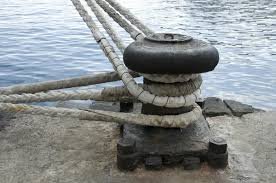What is a shipping Mooring Bollard?
20/08/2024New product – Beenest airbags
21/08/2024What are Mooring Posts? A Comprehensive Guide to Their Role in Maritime Operations
Mooring posts, also known as docking posts or berthing posts, are essential structures in maritime operations, designed to secure a vessel's mooring lines and ensure the stability of ships or boats when docked. These posts, commonly found on docks, piers, or quaysides, are crucial for preventing vessels from drifting due to environmental factors like tides, currents, or wind. Understanding mooring posts, their design, functionality, and importance can significantly enhance the safety and efficiency of port operations.

Key Features of Mooring Posts
Design and Material:
Mooring posts, sometimes referred to as mooring piles or quay posts, are typically cylindrical or rectangular structures made from durable materials such as steel, iron, wood, or concrete. The choice of material is crucial, as it directly impacts the post's ability to withstand the forces exerted by mooring lines. Whether you're dealing with steel mooring posts or wooden mooring posts, the design is tailored to provide maximum strength and durability in various marine environments.
Functionality:
The primary role of mooring posts (or vessel securing posts) is to serve as secure attachment points for mooring lines. These lines are tied around the post in different configurations, depending on the vessel's size and type. A well-designed mooring post, sometimes referred to as a mooring stanchion or mooring pillar, is integral to maintaining the vessel's position, especially in busy ports or during adverse weather conditions.
Placement:
Proper placement of mooring posts is key to their effectiveness. They are strategically installed along docks, piers, or wharves to evenly distribute the forces from mooring lines, ensuring the vessel remains securely moored. The strategic placement also helps prevent unnecessary stress on any single point, reducing the risk of mooring failure.
Capacity:
The capacity of mooring posts refers to the maximum load they can bear, which varies based on the material, size, and design of the post. High-capacity mooring posts are essential for handling larger vessels or enduring harsh weather conditions, ensuring that even the most demanding mooring situations are safely managed.
Importance in Maritime Operations
Mooring posts, or harbor posts, are indispensable in maritime operations, providing a secure means to anchor vessels at docks and prevent them from drifting. Their robust construction and strategic placement ensure the safety of the vessel, crew, cargo, and port infrastructure. Properly maintained mooring posts contribute significantly to the overall safety and efficiency of maritime activities.
Differences Between Mooring Posts and Mooring Bollards
While both mooring posts and mooring bollards are used to secure vessels, there are notable differences between the two:
Design: Mooring bollards often feature specialized shapes (like T-head or double bitt) and are generally shorter and wider than mooring posts. Mooring posts are typically taller and more cylindrical, offering different handling characteristics for mooring lines.
Usage: Mooring bollards are commonly used in large commercial ports for securing big vessels, whereas mooring posts might be more prevalent in smaller ports, marinas, or older docks, especially in regions where traditional mooring methods are still in practice.
Where to Find Mooring Posts
If you're looking to purchase mooring posts, also known as pier mooring structures, numerous mooring post manufacturers offer a variety of designs and materials tailored to different maritime needs. Whether you need high-capacity steel mooring posts for commercial ports or durable wooden mooring posts for smaller docks, the right supplier can provide solutions that meet your specific requirements. It's essential to consider the mooring post price alongside quality and durability to ensure you're getting the best value for your maritime operations.
Conclusion
Mooring posts or marine tie-downs play a crucial role in securing vessels at docks and ports, ensuring that ships remain stable and safe. By understanding the design, capacity, and proper usage of mooring posts, maritime operators can enhance the safety and efficiency of their docking procedures. Whether you're involved in large commercial port operations or managing a smaller marina, investing in high-quality mooring posts is essential for maintaining the integrity and safety of your maritime activities.
